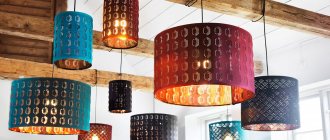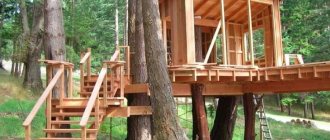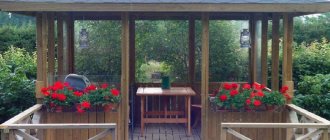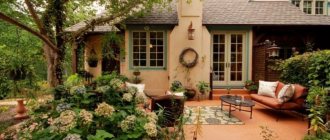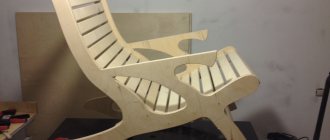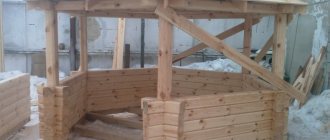When decorating the territory of a summer cottage or near the house with green spaces and original flower beds, there is a need to save free space and create special conditions for growing flowers, garden or garden crops.
Having chosen the trellis photo you like, presented in a wide variety, you can independently make this simple design, which will help transform the landscape design of the site and add a special zest to it.
How to properly secure (tie) blackberries to a trellis or other structure
After building the support, you need to learn how to tie up plants correctly. Regardless of whether a support, stand or trellis is used to support the branches, care must be taken to ensure that the material with which they will be attached to the frame is natural and does not damage plant tissue. To do this, you can use old nylon tights, cutting them into strips, or regular cotton fabric.
Video: blackberry garter on a trellis
Each two-year-old shoot is tied to one side of the support, and one-year-old shoots are tied to the other. They begin to attach the branches to a trellis (another structure) when they reach a height of 50 cm. To do this, wrap a strip of fabric around the branch in a ring, and then put the two free ends behind the wire and tie it. Thus, a figure-eight fastening is obtained, which avoids friction of the branch on the twine or wire. Instead of fabric, you can use special plastic fasteners in the form of the number “8”. Such a device is attached to the wire with one ring, and to the branch with the second.
Pergola swing
This option is more difficult to manufacture, and more materials will be required. The frame must be strong to support the weight of the swing. It needs to be well strengthened, since it will have to withstand not only static, but also dynamic loads.
To make a pergola with a swing you will need:
- timber 100x100 mm;
- board 50x150 for load-bearing beams;
- slats for gratings 20x40 mm;
- bolts and screws for wood;
- waterproofing mastic;
- waterproof paint;
- concrete for the foundation.
The work is carried out in several stages:
- We dig or drill holes 70-80 cm deep.
- Add crushed stone to the bottom and compact it.
- We treat the wooden post at the base with liquid mastic and wait for it to dry.
- We level the stand into the well, fix it and pour concrete.
- We cut nests in the floor beams for cross boards.
- We lift the beams and fasten them to the posts with bolts.
- We strengthen the upper belt with braces. To do this, we cut the boards at 45° and fasten one end to the pillars and the other to the floor beams.
- We assemble the grilles from slats and install them in the side openings.
You can make a swing yourself or buy ready-made ones. For fastening, we screw a special hanger for the swing to the supporting beams, not to the cross boards, as they may not hold up. We pass the chains through the fasteners and hang the swing. We put soft pillows on the seat - and a comfortable pergola with a swing is ready. This design is a great place to relax for all those who like to swing. You can install it near a gazebo, swimming pool, barbecue area and enjoy the results of your labor in the lap of nature.
Decorative techniques: ideas
Diagonal gratings, which are often found on wooden gazebos, give an original and stylish look. Most often, a tilt angle of 45 degrees is used, the slats intersect each other at right angles. Only the pitch of individual elements can differ. If it is frequent and does not exceed 10–15 cm, then a fairly dense screen is created that provides excellent protection from the sun and allows you to hide the interior. A wider spacing of slats of 15 - 25 cm can create an atmosphere of lightness and openness, then the interior of the gazebo practically merges with the surrounding landscape.
The direct arrangement of intersecting slats will look even more original; you can combine them with inclined ones, for example, on adjacent walls. Such structures can also be very successfully used to support climbing plants, then instead of walls the gazebo will have a real hedge. You can use several slats of different widths to create a non-standard complex pattern with different pitches and openings, you just need to show your imagination properly.
Bonded slats for sheathing, also called trellises, can be connected in different ways. The technology of connection and fastening to the frame will not be much different, but the choice of pattern is very diverse, it is practically not limited by anything. The already mentioned lattice patterns with inclined slats are called “diamond”, with straight slats – “square”, trellises diverging from the bottom up from the center – “mill”, inclined ones with alternating directions – “chevron”. There are other schemes, you can create your own design.
It is worth considering that wooden gratings are appropriate not only on the walls, but also on the roof of the gazebo. If you make the top of the structure from massive beams intersecting at right angles, and also add climbing plants along them, then such a project will look simply fantastic. Such a “roof” will not protect from rain and scorching sun, but will add lightness to any architectural solution for a garden gazebo. Often such lattice top floors are made in pregola, which have become especially popular in recent years.
Often, caring owners glaze gazebos in their suburban areas. Their advantages are obvious: they perfectly protect from cold and rain, you can cook food in them and organize family gatherings in any weather. A good example of glazed gazebos are Finnish closed versions with 6 or 8 walls and an internal stove. Internal decorative grilles can be glazed with ordinary mineral, organic, tempered glass or transparent polycarbonate.
The question often arises about painting the load-bearing elements of gazebos and their decorative grilles. Many owners, especially looking at the arrangement of modern courtyards, choose bright, catchy colors for their country buildings. This is not entirely correct, since any wood itself has a pleasant natural color and does not require painting.
Variety of gazebos
Gazebos always look unusual and different from each other. Each has its own feature: one is domed, the other is hexagonal, the third is in the form of a pavilion. The interior decoration also differs: it is either a grill, or a carved one with chairs and a fireplace, or there is a ladder. Why not expand this list of gazebo interiors - why not make decorative grilles that will be intended only for gazebos?
What should I do? Is there really no way out? And he is! You don’t need to go to a psychologist to protect yourself from splashing out your emotions on people in the form of a scandal, or to go abroad to feel peace of mind. You just have to turn your attention to the fact that peace and grace are nearby. And we can find it in nature.
Just imagine: caressing and warm rays of the sun, a light and gentle wind, the chirping of birds, the sounds of rustling leaves and grass, somewhere in the distance the buzzing of bees and the echoes of the clicking of butterfly wings... this is relaxation! Fresh air is always good for you.
Types of gratings
There are several types of gratings for arranging gazebos on a summer cottage or personal plot:
Wooden gratings have their own characteristics and can be of the following types:
- In the form of a rhombus. This shape is given to the product by slats installed diagonally (usually 45°).
- Chevron. In this case, the trellises form slats at an angle, which rest against the frame posts.
- Square. The planks are attached vertically and horizontally, forming a square decorative sheathing.
- Mill. In this version, the slats are inclined to form a fan-shaped pattern.
It is wooden trellises that are often used to arrange such a type of gazebo as a pergola.
Did you know? A pergola is a structure in the form of a canopy. Supports of this design are made of arched sections that are repeated and connected to each other by bars. Initially, the ancient Romans began to make them for grapevines, and then the structure began to be used to protect from sunlight in the heat and create shade.
Variety of gazebos
Gazebos always look unusual and different from each other. Each has its own feature: one is domed, the other is hexagonal, the third is in the form of a pavilion. The interior decoration also differs: it is either a grill, or a carved one with chairs and a fireplace, or there is a ladder. Why not expand this list of gazebo interiors - why not make decorative grilles that will be intended only for gazebos?
What should I do? Is there really no way out? And he is! You don’t need to go to a psychologist to protect yourself from splashing out your emotions on people in the form of a scandal, or to go abroad to feel peace of mind. You just have to turn your attention to the fact that peace and grace are nearby. And we can find it in nature.
The simplest garters
You don’t have to make a trellis for blackberry bushes, but tie it to an elementary support.
You can use it as:
- fence;
- frames and stands for bushes;
- different types of supports.
Fencing
Blackberries can be used as a hedge. To do this, plants are planted at a distance of 1 m from the fence with a height of about 2 m. As the bushes grow, branches are tied up on the fence, as well as on a trellis, distributing them in height.
Frame and stands
If your blackberry is a variety with short vines (up to 1.5 m), you can use frames and stands for bushes. You can buy them ready-made or build them yourself. These types of support rigs are simply placed on the plants immediately after planting. They can have different configurations: cone, cube, etc.
Supports and supports
For small-sized single bushes, you can use different supports for climbing plants, which are small mesh installations. You can also install separate sticks in the form of spears (forked at the top) supporting the fruit-bearing branches.
DIY supports for climbing plants - master class
Relaxing in the summer in a shady corner of the garden, hidden from the scorching sun by thickets of beautifully flowering vines, is the dream of many summer residents. To create such green screens on your site, you will need climbing plants and supports for them.
You can choose climbing annual plants or liana shrubs, in which only the leaves die off in winter. They can be used to decorate existing buildings on the site, for example, a gazebo, barn, porch of a house, facade, fence, or you can make various trellises, arches and other garden structures for climbing plants, which will serve as a support for them and create green rooms or sheds on the site.
Where to begin
To begin with, you can try planting sweet peas, reaching a length of 2-3 m, tricolor bindweed, with bright funnel-shaped flowers, morning glory, decorative beans, and climbing hops.
These plants germinate well, require minimal care and quickly grow around the support. Varieties differ in terms of flowering and various colors of flowers; basically, all of these annuals bloom until autumn. The secret of success is a sunny location, timely watering and fertilizing.
Always in fashion
For those who have already decided on the options for vertical gardening of the site, perennial vines are more suitable. Clematis violet has stems 4-5 m long, the plant is decorated with large flowers of purple-red color. Clematis Jacquemman has flowers of various colors, stems 2.5-3 m long. A bright location, fertile soil, without stagnant water is suitable.
For spectacular flowering, clemetis need to be pruned depending on the group and covered for the winter. All clematis are divided into several groups according to flowering time - early spring, spring and summer, summer and autumn. Some clematis from these groups are not pruned at all, only broken shoots are removed, while others must be pruned. For example, clematis that bloom on old shoots in the spring are not pruned.
DIY plant support - master class
1. First of all, decide what size the lattice will be; it is better to immediately make it for the entire length of the plantings. Draw a plan on the ground, measure the required width between the vertical slats.
2. Lay out the slats according to the drawn diagram, mark the attachment points for the horizontal slats. At the bottom of the trellis, the distance between these slats can be narrower, so that young and short plants can easily cling, and in the middle of the trellis, make the distance larger and the same along the entire length to the very top.
H. At the intersection of horizontal and vertical slats, fasten them with two self-tapping screws.
4. It is better to paint the finished grille so that the structure does not fade or darken from rain. This grille can be secured with self-tapping screws to the wall of a house or gazebo. Another option is to attach it to poles or other supports in the garden.
OUR TIPS
It is better to plant several different varieties of peas, of different colors, or purchase a mixture of seeds at once.
Please note that sweet peas also have low compact plants about 20-25 cm high, some form bushes up to 30 cm.
Popular varieties of sweet peas for vertical gardening: “Melody Bicolor Mix”, stems up to 150 cm long, a mixture of colors, “Spencer Red”, stems up to 250 cm long, large red flowers, “Bonton lilac-violet”, stems up to 250 cm long , lilac-violet flowers, “Royal Family”, stems up to 250 cm high, fragrant flowers of different colors.
A simple solution
The simplest pergola for beginners is a roof in the form of crossbars (on which ivy or vines grow) supported by 4 beams.
Let's take a step-by-step look at how to build it yourself.
What you will need
Pine is good for constructing a pergola, as it is the most inexpensive type of wood. However, it must be well dried, otherwise the structure will then move, and it is extremely difficult to level it. The table shows building materials, sizes and quantities.
Preparatory stage
1. Using a jigsaw, cut the edges of the beams - timber (those indicated in the table in the amount of 9 pieces and with a cross-section of 100x100x3000 mm).
2. On the remaining beam, which will go under the racks, make recesses for the longitudinal floor beams:
- fold 4 beams together;
- align in height;
- fasten with clamps;
- make markings: from the edge - 90 mm;
- recess depth - 25 mm;
- make multiple cuts with a hacksaw from the cutting line to the edge;
- knock down the partitions with a hammer;
- process the recesses with a chisel.
Make notches on both sides of the beams.
Toner treatment
Toner is a paint specially designed for wooden buildings. It has a lot of advantages:
- tints (you can choose any shade);
- preserves the natural texture of wood;
- does not require applying a fixing layer of varnish;
- gives the material such practical properties as hydrophobicity and ultraviolet resistance;
- protects against external negative influences.
Therefore, instead of regular paint, purchase toner and treat the prepared timber with it in 2 layers - this will be enough for a reliable, durable coating. Algorithm of actions:
- Sand the details.
- Protonate them in one layer.
- Wait until completely dry.
- Protonate a second time.
- Wait until it dries completely a second time.
Another undeniable advantage of the toner is that after 2-3 years, when the need for repainting arises, you will not need to peel off the exfoliated pieces. All you need to do is go through the sander and retonate (only 1 time).
Marking on the ground
1. Using pegs and rope, mark the area where the pergola will stand. Dimensions - 2.6 by 3 m.
2. Make holes for the supports (with a shovel or drill). Depth - 1 m.
3. Place the beams in the holes so that the cuts run along the long sides of the markings. Make sure they are at the same height.
4. Fill the holes with cement mortar. Let it harden.
Installation
1. Mount longitudinal beams (those 4 m long) on recesses. Leave the edges to protrude 40 cm beyond the posts.
2. Drill through holes with an electric drill (they are needed for the bolts holding the beams and the rack together).
3. Secure the structural parts with bolts and nuts.
4. Place crossbars evenly along the top of the longitudinal beams, securing them with clamps and securing them with self-tapping screws.
Inside you can put a table with chairs and flower pots. Plant climbing plants along the ceiling and counters - virgin grapes, garden ivy, golden hops or tropical dicentra. This design option can be draped with airy translucent fabrics.
Advantages of using trellises in landscape design
- The purpose of a trellis in landscape design is not as clear as it seems at first glance. This structure really supports and directs the plants in the direction the gardener needs, but, in addition to this, the support has other advantages of use:
- any flowering or climbing crop, after being fixed on a trellis, will be able to maximize its decorative qualities, since it will not get dirty on the ground and get tangled with other plants;
- using supports of various shapes, you can hide unattractive places in the garden, as well as crooked and ugly walls of buildings and old fences;
- the horizontal construction of the trellis allows you to think about the high-quality placement of the roof, so it is sometimes installed as one or several walls of the gazebo;
- with the correct selection of plants for growing on a trellis, you can not only beneficially add greenery to your plot, but also create shade in the most suitable place for this;
- If desired, real labyrinths of plants can be created using supporting structures; you just need to place the products in the appropriate direction.
There are indeed many reasons for using trellises in landscape design, but one should not forget that the desired effect from their installation can only be achieved if the area is properly planned and the most suitable types of flowering and climbing plants are planted next to the support.
General recommendations
The design of a pergola is very similar to a lightweight canopy or gazebo. Its characteristic features are repeating sections connected by horizontal beams. Another type of garden and park galleries, where the ceilings have an arched shape, is called berso. But often they are united by a general concept without specific distinctions.
The pergola can be free-standing or adjacent to the building. Wood, metal or combinations thereof are used for manufacturing. Since the structure is quite light and has low windage, an excessive strength resource is not required. Materials such as brick, concrete or stone are used for large structures with large spans.
Making a garden trellis
The main task is to correctly connect the two slats crosswise. This is best done using a square-shaped block. Moving along the rail and using the block as a measuring material, you need to secure several more slats along the entire length of the horizontal guide. Moreover, all of them must be secured with an offset, as shown in the figure. The correct displacement of the slats is done using an oblique guide, which is attached to the main one at an angle of 45°.
1c938b3860c9f13f18c905de2d7244d3.jpe
The remaining slats are attached using the same principle, after which the trellis is almost ready.
All that remains is to fill in the corners. This is done according to the same principle, only shorter slats are used for the corners. After completion of the work, the garden trellis is secured with an edging crossbar (possibly thicker) and installed in its intended place.
It will only take you a few hours to make a wooden trellis, and another half a day for painting or varnishing. After this, they can be used for their intended purpose.
In the example given, you must fill 9 slats with an offset on the main guide, and subsequently do the same to fill the entire plane. The trellis can be trimmed using an edging strip located at an angle of 90° to the additional guide. The corners on each side are filled with three pieces of wood of shorter length. Finally, slats are placed on both sides of the edge of the trellis along the perimeter - and the garden fence after varnishing or painting is completely ready.
What is a trellis
A trellis is an element of a garden or vegetable plot, with the help of which it is possible to achieve fixation of plants in the most acceptable position for the gardener. When decorating a site, a lattice structure is most often used than others, acting as a vertical support for tall and climbing crops.
If it itself has a bizarre shape or is supplemented with any figures, then, together with the plants themselves, it can serve as an excellent garden accent, attracting the attention of both the gardener himself and his guests. The trellises are attached to the walls of any garden buildings on the site, to pergola posts, or they are installed as an independent decorative element in the most suitable place for this.
Important! When creating a trellis, it is worth considering the future weight of the crops growing on it. The individual structural elements of the product must withstand the maximum weight of the vegetation, even if it also changes with the change of season (the maximum possible values are taken into account)
The individual structural elements of the product must withstand the maximum weight of the vegetation, even if it also changes with the change of season (the maximum possible values are taken into account).
Important! When creating a trellis, it is worth considering the future weight of the crops growing on it. The individual structural elements of the product must withstand the maximum weight of the vegetation, even if it also changes with the change of season (the maximum possible values are taken into account).. Classic trellises fixed to the wall of a residential building are often used to decorate the front entrance, especially if they have straight and diagonal shapes, due to which an original combination of shadow and light is created
This can be a very small structure intended only for one type of plant being grown, or a relatively long structure dividing the territory into several functional zones.
Trellis gratings in most cases are made of wooden slats, additionally framed by a decorative frame of beams with a wide cross-section. It is the frame that protects the product from deformation and provides it with sufficient stability
Classic trellises, fixed to the wall of a residential building, are often used to decorate the front entrance, especially if they have straight and diagonal shapes, due to which an original combination of shadow and light is created. This can be a very small structure intended only for one type of plant being grown, or a relatively long structure dividing the territory into several functional zones.
Trellis gratings in most cases are made of wooden slats, additionally framed by a decorative frame of beams with a wide cross-section. It is the frame that protects the product from deformation and provides it with sufficient stability.
Grill assembly
Classification of weatherproof wood paint for lattice coating.
Let's start filling it out. For this you will need the same slats as for the rebate. They need to be placed diagonally at an arbitrary but equal distance. To maintain the exact distance between the slats, it is convenient to use a wooden template. Accuracy and thoroughness in performing this stage of work will give the product beauty and grace, emphasizing the correct geometry of the elements.
We connect the 2 frames made in this way to each other so that the lattice slats intersect crosswise and press tightly against each other. We fasten the frames together with glue and screws or nails.
673b58afae8180064f5671388ca49283.jpe
If you decide to make a more massive trellis for the base of climbing plants, and even more so, if you decide to completely block the opening or several openings of the gazebo with trellises, then it is not necessary to make a frame: the trellis itself is already a frame, giving the structure the strength and necessary rigidity from intersecting installation fragments among themselves. By choosing larger bars with a cross-section of 20x40 mm, they can be attached directly to the main frame of the gazebo, carefully trimming and adjusting the size of the bars to the location.
After the grille is assembled, if necessary, its surfaces are treated with sandpaper, and then the entire grille is varnished. Very often, the grilles on the gazebo blend perfectly with the surrounding landscape and buildings by highlighting them in a different color. Therefore, instead of varnish, you can use any weather-resistant wood paint.
http:
Preparatory stages
First of all, draw a drawing of the lattice. To do this, measure the required height and width in advance, or determine them based on the drawing of the gazebo itself. After this, mark whether the top and bottom sections will be straight or curly.
Select a pattern and calculate the desired cell pitch. To better imagine the result, you can lay out several slats in front of you. If necessary, adjust their pitch, making it tighter or wider, and finally measure the resulting distance.
Mark the type and pitch of the sheathing on the drawing and calculate the required amount of material.
Don't forget about the tool
Prepare your tools. To make the grating you will need:
- knife or chisel;
- hacksaw with fine teeth;
- hammer;
- forceps;
- nails or screws;
- square;
- roulette;
- antiseptic;
- varnish;
- wood glue.
For sheathing, slats with a cross section of 1x2 cm and beams of 2x4.5 cm are often used, but you can choose them at your discretion.
How to make a wooden cucumber stand yourself
It will take approximately two hours to make. The support should be erected after planting the seeds, but before the first shoots appear.
Here are instructions on how to make a support for cucumbers:
- Decide on the type of structure.
- Install the pillars, maintaining a distance of 1.5-2 m.
- Secure the supports at an angle of 70 degrees and anchor them with guy wires.
- Build a frame by nailing a horizontal cross member to the top of the support posts.
- Perform the sheathing. It is best to use thin slats 30 mm thick for this. The optimal cell size for cucumbers is 15*15 cm.
To build a trellis for cucumbers in open ground, experts advise choosing hardwood - chestnut, oak, ash, mulberry.
If properly designed, a cucumber trellis can adequately decorate your site, acting as a non-standard element of landscape design. Therefore, there is no need to spare time and effort on its construction.
(4 ways)
Method one (put on top and nail)
This is the easiest way - take our horizontal beam and simply place it on TOP OF our support posts. And secure it with a long screw.
One important detail
– in order for such a fastening to be resistant to gusts of wind and other loads, we will screw one screw vertically (through the beam - in the center of the support column) and insert two more screws at an angle (on the left and right) - like here in the photo.
Method two - metal plate
We also place the beam on top of the support post - and attach two L-shaped (or one T-shaped) metal bracket and drill it with screws.
On the other wall of the beam, we do the same.
Method three - groove in the support column.
You can make a groove in the support column itself (choose the width of our horizontal beam). And insert a beam into this groove
. The method is good, reliable - in ancient times this is how they did it, without nails. In our time, it is still recommended to secure such a “groove” connection - so that it is stronger.
You can do the same work on the ground
(below) – so as not to climb so high... it’s scary..
...and then install the pillars - immediately with horizontal beams inserted into them...
This is only suitable if your pillars will not be cemented into the foundation... and then you can assemble the frames on the ground (2 pillars + a horizontal beam and again 2 pillars + a horizontal beam) - and then install these two “portals” in the planned location... and finish the roof. Decide what is more convenient for you...
Method four (without beams) – EDGING BOARD.
Why do we need beams (boards are cheaper). And the horizontal beam can be replaced with two edged boards placed on the support post on one side and the other (Fig. 1)
The top of the post can be left sticking out - we can then attach transverse beams-boards to it (Fig. 2). Or we may not leave...
This method is good because -
that there is no need to lift heavy beams to a height (the board is much lighter). I found a video on YouTube where a young married couple assembled such a pergola together) the wife held one end of the board - the husband drilled the other... It was nice and friendly - they did everything in one evening.
Types of trellises
Trellis for blackberries can have different designs. Such a device can be purchased at specialized sales points or made with your own hands. Most users prefer making their own. This design does not require large financial investments, since it can be built from materials available on the farm. Making a trellis is quite simple, even without experience in this matter.
Did you know? In a number of European countries, blackberries are used only as an ornamental garden crop, and America grows the largest number of berries on an industrial scale.
There are the following types of trellises, depending on the type of structure:
- single-lane simple;
- two-way simple;
- T-shaped;
- V-shaped;
- S-shaped;
- negotiable;
- pergola;
- arch.
Single lane simple
This design is divided into several types:
- fan;
- vertical flat;
- free;
- inclined;
- horizontal.
In fact, all varieties are several pillars driven in at the beginning, middle and end of the row, 2–3 m high. Between them, a wire is stretched in 2 rows (the first is at a height of 50 cm from the ground, the second is 2 m). The only difference is the method of tying up the vegetation. This type of trellis is suitable for small plantations, since each branch needs to be fixed separately, which will be inconvenient for large areas due to its high labor intensity.
Two-way simple
The type of trellis in question is similar in design and size to the previous one. The difference lies in the location of the strips for fixing the lashes. The ropes are pulled at a distance of 50 cm from the soil parallel to each other. Do the same with the second row of ropes, located at a height of 2 m from the soil.
According to the type of fastening of ropes for fixing the lashes, two-lane structures are divided into:
- T-shaped;
- V-shaped;
- S-shaped.
T-shaped
In such a trellis, the posts on which the rope is held for fixation are made in the shape of the letter “T”. The bases are installed at the end and beginning of the row. The wire is attached along the outer edges of the poles in 3 rows (at a height of 50, 100, 150 cm). During the growth of the bushes, the shoots are fixed on both sides, which allows the central area to be left free.
In this design, the base is shaped like the letter “V”. Attaching the branches is carried out similarly to the previous option.
b6819541f85b42c08a0b5c36d6ef41e7.jpe
S-shaped
The essence is the same as in the two previous variations - the base is designed in the form of the letter “S”. Tension threads are attached to the upper, lower and central parts of the warp.
Did you know? Ripe blackberries have a mild laxative effect, while green ones, on the contrary, have
an astringent effect.
Negotiable
The moving, or reversible, trellis is a rather complex structure. Such devices are used in the USA in industrial plantings. They are adapted in such a way that when flowering begins, the frame with fixed branches turns almost parallel to the ground.
As the berries ripen, it is raised to a vertical position. The frame is driven by a rotating mechanism fixed next to the base, which can be designed according to one of the above options. The height of the structure is 3 m, and the length, depending on the area of plantings, can vary from 5–10 m to several kilometers. Reversible trellis at the time of flowering bushes:
Pergola
A pergola is a kind of net or fence to which branches are tied as the bushes grow. This type of structure has a beautiful decorative appearance, which allows it to be used as a support for a hedge. If you install several of these structures in the form of a square, you can create an unusual gazebo. The height of the structure is 2.5–3 m, the width depends on the length of the row of plantings.
Arch
A trellis-arch allows you to form a beautiful row of blackberry bushes or a gazebo, which will act as a decorative element in the garden. The shoots are fixed parallel to each other, which allows for good illumination by sunlight. The height of the structure is about 3 m, the width is arbitrary.
Briefly about the main thing
A decorative wooden lattice for a gazebo covers the interior space from prying eyes, decorates it, and protects it from direct sunlight. It’s not difficult to make it yourself if you have the necessary materials.
Different types of wood have characteristic properties, texture, and colors. You can, without resorting to dyes, use wood of the desired color to create an original gazebo decor. And if you try to create a complex pattern, you will get a unique creation.
Source
Unusual materials when creating a trellis
In an effort to save on materials or in the desire to repurpose unnecessary trash, we often find interesting solutions. We share them on the Internet and they gain popularity. For example, trellises made from plastic pipes and remnants of reinforcement structures have now become popular.
This technique is suitable for creating a super-strong frame. It can withstand even large quantities of ripe grapes.
To create the design you need:
- The armature is 300 cm long, 1 cm in diameter, made of iron.
- A plastic pipe with a length of about 60 cm and a width of 1.3 cm.
- Metal clamps with screw.
- Tool for working with metal.
The most important step is correct measurements and, based on them, accurate calculations. If you make a mistake here, the design may not work out or its appearance, stability, etc. will suffer. The above materials are enough for a trellis with a width of 250-300 cm. The length will vary depending on the number of plastic pipes.
Stages of creating a trellis step by step:
- the reinforcement is divided in half, each should be 150 cm long;
- 150 cm of reinforcement is placed in the corners of the future structure; they should go 40-60 cm into the ground;
- Every meter it is necessary to drive additional supports into the ground;
- pipes are placed on top of all protruding supports, which forms the basis for the structure;
- Next, using clamps, a longitudinal row is created, the distance between them should be about 70 cm.
The result is a very durable and, most importantly, safe structure. It can withstand even particularly powerful vines.
And most importantly, the materials for its manufacture often remain after country renovations, and the service life is much longer than that of structures made from natural materials. Since plastic is not subject to rotting, it is not afraid of moisture, dirt or temperature changes.
Metal
If you want to install a metal pergola, it is better to make it from profiled pipes with a rectangular cross-section or fittings.
Choice
Metal pergolas are quite varied in their design. So it’s worth starting with a choice:
- hinged, arched, semi-arched, gallery;
- dynamic and static;
- single-row and multi-row;
- decorated with forged elements and as simple as possible in decoration.
You should choose a model not only taking into account its beauty and functionality, but also from the point of view of the ease of its installation, because everything will have to be done with your own hands.
Sketch
The construction of a metal pergola begins with a sketch. It requires much greater precision than when constructing a wooden one. It’s easy to saw the wood, remove the excess, make another notch or fill up the unnecessary one. It's difficult to do all this with metal.
Material selection
First of all, you need to choose the right type of wood. To create decorative grilles, the following are most often used:
- Ash. Beautiful, durable and resistant to adverse environmental influences. Easily processed. Many consider it the ideal choice.
- Oak. Strong and durable, bends well, looks attractive. However, it is a very hard material that requires experience to work with.
- Pine. Aesthetic, durable, pliable. The advantages include a pleasant pine aroma and disinfectant properties.
- Larch. Durable, resistant to dampness and rot, lasts a long time.
- Beech. It looks very beautiful due to its pinkish color, but is not resistant to moisture.
There is a plastic sheathing on sale that imitates natural wood. It doesn’t look as attractive and is less durable, but you can use it to quickly create a gazebo.
91a51dec95a01ce66c3391527237a69e.jpe
Why is sheathing needed?
Making lathing for a gazebo can hardly be called a non-trivial task. The process requires accuracy and attentiveness. The design of the sheathing allows you to give the building a complete look by removing large openings.
At the same time, the sheathing provides a higher level of privacy, shielding visitors from the prying eyes of neighbors or passers-by. Fabric cannot replace the sheathing, since the latter does not prevent the flow of fresh air.
On a sunny day, the lathing will bring more comfort inside the gazebo, partially shading the area. It is easier to install an anti-mosquito screen on the grille, which will provide protection against annoying mosquitoes. In addition, this addition to the gazebo is perfect for climbing plants that can freely entwine the structure.
Selecting the type of trellis, calculating the material and tools
For creeping blackberry bushes, any type of trellis is suitable; for upright ones, one- and two-cavity ones (except for the reverse one), since their shoots are not so flexible. But it is best to construct a simple three-level, two-cavity support, which is considered universal and suitable for different varieties.
Tools for constructing trellises will be required:
- shovel;
- drill and drill bits for it.
To create a frame you can use:
- tree;
- polypropylene pipes;
- metal;
- wire or twine.
Tree
Wooden piles are most often used in small areas. They are quite stable and can withstand high tensile forces, but are subject to rotting processes too quickly (especially the part that is in the ground).
When using wooden beams to create a structure, they are pre-whitened along their entire length. The lower part, which will be buried in the ground (about 50 cm), is wrapped with water-repellent film.
Metal
Metal frames are more reliable than wooden ones, but are susceptible to corrosion
When choosing such material, you should pay attention to galvanized pipes and channels
Polypropylene pipes
The frame made of polypropylene pipes is very light, so constructing the trellis will take quite a lot of material. For example, when using wood and metal, you can install the bases only at the beginning and end of the row. If you use polypropylene material, you will have to install foundations between every 2 bushes. It is better to use them to make frames for low-growing varieties of blackberries.
Wire or twine
Both wire and twine can be used to secure branches. These materials are strong enough to support shoots along with the harvest.
Find out what blackberries on your site get along with and what they don’t.
Calculation of the length and height of the trellis depending on the selected type
All structures will have approximately the same dimensions in height - 2.2–3 m. The length of the frame depends entirely on the number of bushes in the row. If the area of plantings is quite large, then support pillars need to be installed not only at the beginning and end of the row, but also in the center, with an interval between them of at least 6 m. The length of the pile will be equal to the height of the finished structure + 60 cm (depth of the pit). For example, if you plan to make a trellis with a height of 2.2 m, then piles with a length of 2.2 + 0.6 = 2.8 m will be required.
Scheme of a three-level trellis:
Tree care
It is advisable to take up these procedures before you start assembling the structure. We are talking about impregnation of frames and grilles, treatment with antiseptics and, if desired, paint. It's also best to paint the frame before you attach the grilles into place. If you paint finished structures, there is a high probability that some places will remain unpainted. This will make the condition of the gazebo worse.
Durability will also suffer due to the fact that not everything will be protected. At the moment, there are many types of antiseptics on the construction market, thanks to which you can preserve the color of patterns. They can also be used before you start painting the sheathing for the gazebo.
Construction of the foundation
Even if the future country pavilion is an open-type mobile structure, you will need a foundation. To install any structure, you need a hard, flat surface designed to bear a certain load.
Step-by-step instructions for creating a foundation:
- Clear the selected area.
- Dig a pit of the required depth.
- Place a layer of sand, old tires, stumps or tree cuts on the bottom (the material is selected depending on the method of constructing the base).
- All free space is filled with cement or concrete mortar.
- Next, they make the bottom trim and begin to build the frame of the gazebo.
